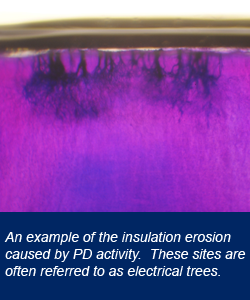FACTORY GRADE® TECHNOLOGY
FACTORY GRADE® TECHNOLOGY
Learn More
What is "Partial Discharge"?
Cable systems are designed to withstand a significant amount of electrical stress. Anything that causes a localized increase in that stress can lead to PD activity:
- Voids in the insulation
- Damage to the cable from the backfill
- Protrusions such as nails, tacks, or other objects
- Insufficient grease used during accessory installation
- An improper “cut back” during accessory installation
- Moisture infiltration enhancing an existing localized stressor (water trees)
For further examples of cable system issues that can cause PD activity, check out our
PD Blog
What is "Partial Discharge"?
Partial discharge (PD) is an electrical discharge that does not completely bridge the gap between two electrodes. PD happens all the time in power systems, but usually occurs in components that can withstand it (such as switchgear). You may be aware of PD activity near you (that buzz you hear from medium or high voltage substation equipment or overhead power lines). Modern cable and cable accessories cannot withstand partial discharge. In these cases, PD can slowly erode the insulating material until failure.
How does it work? [An example of the electrical trees caused by partial discharge activity in the cable insulation]

- The vast majority of partial discharge does not occur all the time, but rather when the voltage of the cable system exceeds the “turn on” voltage of the PD site (referred to as the PD Inception Voltage, or PDIV).
- Surges in the power cable system (caused by switching, lightning strikes, etc…) can cause the cable voltage to momentarily exceed PDIV, leading to a burst of PD activity and erosion of the cable or accessory insulation.
- PD activity will continue until the cable voltage drops below the “turn off” voltage of the PD site (referred to as the PD Extinction Voltage, or PDEV).
- Every occurrence of PD activity will degrade the site further, causing the PDIV and PDEV to decrease
- Once the PDEV drops below the normal operating voltage of the cable system, the PD activity and the associated insulation erosion will continue indefinitely (unless the cable is disconnected from power).
- From this point forward, a cable system failure will most likely occur in a short period of time.
